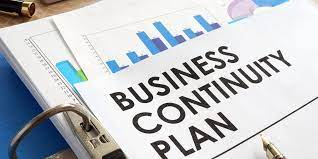HOW TO WRITE AN EXPANSION AND CONTINUITY FOR YOUR BUSINESS
 HOW TO WRITE AN EXPANSION AND CONTINUITY FOR YOUR BUSINESS
HOW TO WRITE AN EXPANSION AND CONTINUITY FOR YOUR BUSINESS
In business, there are always circumstances that will be beyond the organization’s control. With this, a business organization needs to make provision and allowance for this, which may likely reduce the effect of the loss on the organization or business, since provision and allowance for that has been made. Provision in this respect means proper plan for the event, if eventually occur.
What is Business continuity?
This is a process of keeping up with the activities and functions of a business and returning the business back to its normal activities it was before the occurrence of disruptions or disasters. The expected here could be fire, flood, cybercriminals, e.t.c. A business continuity report display the process, methods and instructions that such an organization should follow to restore them back to their initials positions.
Business continuity also covers business processes, assets, human resources and business partner. Your business relies on your customers. If you fail to prepare good business continuity report, it your business may likely be affected, In terms of your business’s reputations and market value. Thus, your continuity report must cater for vulnerable areas and the potential losses expected in your business.
If you do not have business continuity for your business, it is important to have one. This is done by recognizing the vulnerable areas of your business and making necessary plans towards it.
The following steps should be followed in writing your business continuity:
- Identify the scope of the plan
The first step in writing your business continuity plan is to identify the areas that a business continuity plan should address. In doing this, you will have proper awareness and consciousness of the expected disaster by identifying some areas that are exposed or areas where losses may likely occur.
Identifying scope also includes the type of losses which may likely occur from the disruption and making adequate plan and necessary adjustment for its occurrence so it won’t affect the business process.
- Identify the important Business Functions
This will help to identify some important functions or activities in your business that could easily be affected by the disaster. Although some aspect of your business can be recovered back by information technology (IT), but as a business owner, you must understand that not aspect can be retrieved by IT. Your business functions includes; the aspect of business process, asset, human resources and customers.
- Recognise the critical systems and the dependencies between them
It is very important to note in your business continuity plan information that are relevant and most important for your business to continue operation after a particular disruption. This step is more of the data, equipment, machines and other vital information whether in black and white or digital, must be identified for your business to continue operation. Finding the dependencies between them means the ability to understand how this information and data can be so useful in restoring back your business to the position it was before the loss occur.
- Determine your data backup and your recovery plan
In writing your business continuity plan, your business continuity plan must have a data backup and how you want to recover them, how often will your backup process be? Who will carry it out and where will you store the data? How will it be geographically replicated so that no other disaster can result in a permanent loss? All these must be well-articulated and explained in your business continuity plan. You must be able to address those questions in your business continuity plan. And in your business, this step is important, and you as a business owner must address those question in electronic and white and black (paper records).
 HOW TO WRITE AN EXPANSION AND CONTINUITY FOR YOUR BUSINESS
HOW TO WRITE AN EXPANSION AND CONTINUITY FOR YOUR BUSINESS
- Identify your Risks
Here, you need to identify those factors can easily disrupt your activities. Like natural disasters, such as earthquakes, sever outrages, accident data loss, e.t.c. although, you it is possible to identify the one that will disrupt your process, but it is advisable you prepare for scenarios. When this is done, if the unexpected eventually happen, then it will come as a shock. This is very vital and essential factor to identify because the if you fail to identify your most likely occurrence risk, then the reputation of your business will be affected, as well as the market value of your business. Identifying your risk will also help to cater for loss of customers and supplier’s trust.
- Outline the functions and procedures for your business continuity team
This step involves understanding the role of each of employee and procedures for the continuity team. Role of employee in term of who should be notified? And who should be in charge during the time? Where will your management team and other employees? All these questions and other relevant questions must be included and addressed in the real life.
Read Also: How to write a small business plan for investors
- Have a good communication expert and plan
Another thing that must be in your business continuity plan is; getting a sound communicator who will be speaking on behalf of the business, with your business agencies, partners and even government representative if need be. In this case, it also means that having a well-structured plan that will get everybody informed for any emergencies as soon as possible. This involve structuring your communication plan, such that employee will understand what is happening in case of unexpected and also constitute a list of people and or agencies you can contact in case of any emergency.
- Have a training procedures for your employee
This is another step is very important in that every of your employee need to be trained at an intervals, say, one year. Procedure for training should be updated on a regular basis, because of changes in technology, personnel and organization structure of the business. Thus, training procedures and revisiting the procedures on a regular basis is an important aspect of your business continuity.
What is your business continuity objective?
In writing your business continuity plan, the objective of the plan must be well stated and articulated. Although, business continuity plan objective is geared toward ensuring continuity, even after a major disruption in process. This is reason why it is important for you to identify your objective even in your planning process. For example, your business continuity plan could focus on any of the following depending on your kind of business;
If your business is not more of technology, it would be good for you to have your objective to be more focused on on emergency response protocols and employee safety.
However, if your organization is more of IT operations, it will good to focus your business continuity objective on networking, data storage backup, and more.
 HOW TO WRITE AN EXPANSION AND CONTINUITY FOR YOUR BUSINESS
HOW TO WRITE AN EXPANSION AND CONTINUITY FOR YOUR BUSINESS
More so, apart from the above, there are other things that you need to consider while writing your business continuity plan. These are fundamental component of your business continuity plan for effective communication ability to properly execute your plan.
Basis outline on how to structure your business continuity plan
- Relevant contact record: The act keeping information of those you need to contact first, in case of any emergency. This includes contact of disaster recovery team, partners, stakeholders and investors who should be aware of any disruption. This is a vital part of your business continuity plan and must be put into consideration to be able control the disaster on time and bring the business back to its former track in no time.
- Well-structured objectives: when writing your business continuity plan, you need a well stated and plan objectives to give you definite focus and directions. You need to lay emphasis on your objectives, to know the easiest way to control disruption.
- Assess your risk: when writing your business continuity plan, you need to identify have a section for risk assessment, as it will enable you to know the length of disruption, business systems or area that will be affected and the cos attach to it.
- Precaution: you must include systems that will help to prevent the occurrence of this scenario or system that can reduce it. For example, having fire extinguisher to help in fighting the occurrence of fire outbreak. This must well-articulated in your business continuity plan.
- Responses: In your business continuity plan, you must include how you may respond to disaster scenarios. This response must be things you may likely do following a particular disaster to ensure quick reduction in the occurrence and also to have quick recovery from the disruption.
- Have extra asset: your business continuity plan must state this, in case of any disruption in your primary asset, what would you fall back on? This is very important for quick recovery and bringing your business to on track.
From the above, it must be noted that Business continuity plan is vital for keeping operations running even after unexpected disruption. Through adequate assessment of risk, stating strategies for prevention, responses, and recovery, business can actually reduce the chances and length of interruption to essential services and systems.
If you need a service of a Professional Business plan writer, then Dayo Adetiloye Business Hub is the place to go Call or WhatsApp us now on 081 0563 6015, 080 7635 9735 or send an email to dayohub@gmail.com and we will solve any of your business plan problems.
Hope you enjoy this article?
Share your thoughts in the comment session.
Contact us today for your business consultancy and business advisory services. We can help you fine-tune your idea, structure your business, market your business, train your staff, consult on your retirement plan, coach you for financial success. We also write a business plan and help with fundraising strategies and Grant applications. We can help you start, grow, and expand your business.
Call or WhatsApp us now on 081 0563 6015, 080 7635 9735 or send an email to dayohub@gmail.com and we will solve any of your business problems.
Related